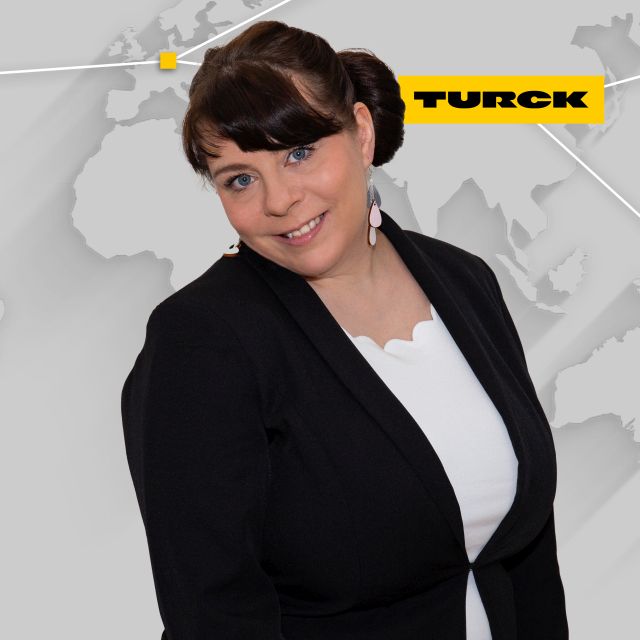The shipment verification station from Turck Vilant Systems in the proof of concept setup
With its shipment verification station Turck Vilant Systems demonstrates in a proof of concept for Merck KGaA Darmstadt that containers with liquids and metal objects can be recorded reliably and quickly in UHF-RFID bulk read operations.
The reliable detection of several RFID tags on a pallet is a challenge, particularly when different objects and liquids are involved. At Merck KGaA Darmstadt initial tests on the verification of shipments with conventional RFID-UHF gates showed that not all substances could be read with sufficient speed and reliability.
The UHF-RFID experts from Turck Vilant Systems took up the challenge and were able to demonstrate with their shipment verification station that even ethanol containers and randomly oriented tags could be identified reliably and quickly.
Starring Yanick Kleppinger, at the time a bachelor student for Merck, and Robert Paulus, Business Development Manager at Turck Vilant Systems.
This is how Merck KGaA Darmstadt has also profited for years from the digitalization megatrend. As part of the digitalization of its own processes, the question was asked in Darmstadt to what extent the recording and verification of deliveries could be automated.
In the logistics area, the answer to this question had for years inevitably been RFID. For larger ranges and the simultaneous recording of multiple tags with so-called bulk reading, only UHF technology can be considered. However, this technology presents a problem for liquids and metals. Both, liquid materials as well as metal containers such as barrels, play an important role at Merck KGaA Darmstadt.
The company therefore had to first of all establish a solid basis of data from which it could be decided whether bulk readings with UHF-RFID could be used at all for the verification of the specific goods and primary products. Yanick Luca Kleppinger, who at that time was working at Merck KGaA Darmstadt as part of his final undergraduate year, examined in his final year thesis the effect of different solvents on bulk detection with UHF-RFID technology.
As part of this study Kleppinger also carried out a proof of concept with regard to the question how well different chemicals and containers can be identified with UHF-RFID technology. In the test setup for this feasibility study, he tested the technology using examples of seven pallets that reflected the variety of containers and substances.
Variety of substances and containers tested
The first three test pallets contained cartons filled with glass bottles. The bottles on the first pallet were filled with ethanol, while those on the other two were filled with other solvents. The fourth pallet held ethanol containers made from plastic and pallet five two 200 liter metal drums. Pallet six carried eight smaller drums made from metal. The seventh pallet was used by Kleppinger to test different containers with powder, bottles, plastic objects and metal drums.
The test with this mixed pallet also included the examination of whether the read results are reliable even with the random positioning of the UHF tags due to optimized packaging processes.
The tests with a conventional RFID gate were promising. The detection of the ethanol pallets did however show differences to the detection of pallets with different solvents. Tags fixed to the inside of the ethanol containers in particular could not be reliably detected. The mixed pallet also presented problems for the conventional RFID gate.
Shipment verification station uses wave reflection on metal walls
The engagement of RFID integration specialists Turck Vilant Systems (TVS) brought a solution. The Turck subsidiary has 20 years of experience in the integration of UHF solutions in several sectors. Besides its own RFID middleware, TVS uses optimal hardware for the application at hand.
“Detecting pallets with liquids in an RFID gate cannot be done with a conventional gate setup,” recalls Robert Paulus, the business development manager at TVS who took care of the proof of concept at Merck KGaA Darmstadt. The tags fixed inside were surrounded by liquids on all sides. As the ethanol still absorbs the waves, the inside tags are not detected.
“We have had good results with our shipment verification station (SVS) in these kinds of applications, says Paulus. The SVS is a metal box on which the three walls and the ceiling are fitted with UHF read/write heads. The pallet with the objects to be identified is inserted through the remaining opening. “In the SVS we make use of the reflection of the waves on the metal walls. The effect is similar to that of a cabinet of mirrors. The electromagnetic waves are repeatedly reflected and thus also detect points on a pallet that cannot be reached by conventional RFID gates.”
Polarity critical for readability
The test with the first three pallets showed that the three solvents had a different reaction to ultra high frequency waves. While the detection of the 120 tags on the pallet containing the ethanol bottles took 30 seconds, the bottles with different solvents could be read in two seconds. The tags on the bottles were read at virtually the same speed as the tags on the cartons, and so the difference had to be in the properties of the solvent. Literature to date had only mentioned that liquids had a dampening effect on electromagnetic waves.
The three liquids had similar viscosities but differed significantly in their dampening properties. Kleppinger looked for a different molecular property that differentiated the three solvents: The result of his study was the polarity of the materials was the critical factor. If this finding can be confirmed with further tests, this will represent a new level of research in future on the effect of liquids on readability with UHF-RFID.
Selection and position of the tags critical
Besides the factors stated, successful read results also depend on the correct choice of tag. Turck Vilant Systems also provided its support here as well as with their optimum positioning on the bottles, drums or cartons. The test of the fourth pallet with ethanol containers made of plastic showed that the key to good readability is the fixing of the tags above the fill level of the ethanol. This enables all 21 tags to be read in two seconds. The tags also must not be covered by metal objects.
On-metal tags use metal as an antenna
The test of the tags on metal drums showed on the other hand that the position of the tags was less of a decisive factors. Special on-metal tags were used here, which use the metal drum as an extension of their antennas. All nine tags on the pallet were read within two seconds. The test with eleven smaller drums confirmed this result. With all read operations the tags should in all cases be pointing in the same direction as much as possible.
Mixed pallets with randomly oriented tags
The mixed pallets carrying drums, plastic containers, cartons and bottles could not ensure the uniform orientation of the tags. Small plastic objects that are filled automatically in cartons are also positioned randomly in the cartons. The read results of the SVS were nevertheless completely satisfactory and suitable for the process. All 82 tags were detected within two seconds – in spite of the random orientation of the tags.
Successful proof of concept result
“After our first test setups and the findings gained from them we were very skeptical about the detection of certain products,” says Kleppinger. “Through the proof of concept that we carried out with Turck Vilant Systems we now know that even difficult products can be reliably and consistently detected with the right method.”
With a read device like the shipment verification station the test pallets examined could be used reliably with all materials for verifying shipments at Merck KGaA Darmstadt and in very good to acceptable read times for logistical processes. Even with the most difficult substance ethanol, the bulk detection operations with read times of up to 30 seconds were impressive. When using the right on-metal tags, metal containers likewise do not present a problem.
The upshot of Kleppinger‘s study and the included proof of concept is that, in addition to proving the suitability of RF identification for processes at Merck KGaA Darmstadt, they have also shown that the polarity of the liquids is a critical factor for the RFID read result.
This finding ought to be considered with future assessments of UHF-RFID applications for liquids. Not every undergraduate research can claim the discovery of such an impact.






